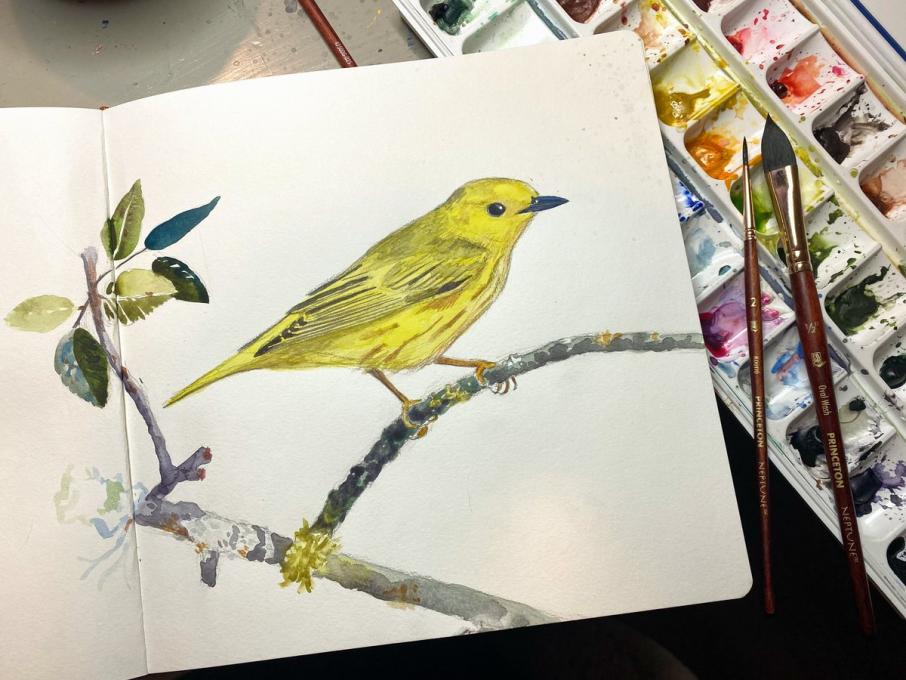The Cornell Lab Bird Academy › Discussion Groups › Nature Journaling and Field Sketching › Jump Right in!
-
l

-

-
I wasn't sure how long to spend drawing it. If it was in the field I suppose it would be a quick gesture drawing depending on how long the bird could stay still. The advantage of the photo would be adding more detail.
-
I was hesitant to start and then pushed myself to rush right in & ended up starting too high on the page so the top of the bird's head is cut off. But once i realized that i relaxed about getting it 'right' this first time. I found myself drawn (pun intended) to the branches in leaves, as a result, zeroing in on the bird's feet, the lichen, leaves & shadowing, which i might not have really noticed if not trying to draw the picture. So i think that drawing in nature journaling leads to looking much more closely at things like beak & wing structures, claws around branches, etc., & could produce richer connections with the subject and so possibly stronger memories of the experience than just taking a photo. . .
-
i felt like i was outside looking at a real bird. I realized that there were tiny strikes of dark yellow on the underside of the belly!
-

-
 If this turns out to be a double submission, please excuse! I found that I can focus on the topic and ignore extraneous details, but I had to work on it, since everything in the photo was clear and detailed. This gave me an accurate portrayal of the bird, and I was able to concentrate on the details in a way that I wouldn't have been able to if I was doing this while watching it. Photos provide a good resource to go to when, after an observation outside, I want to go back and check details on what I've captured in drawing. On a technical note, I was concerned how I was going to show the various shades and tones of yellow, and scoured my pencil box for the "right" color to use. I finally landed on using one color, and found that my shading with a graphite pencil provided the shading I was looking for. A good lesson learned!
If this turns out to be a double submission, please excuse! I found that I can focus on the topic and ignore extraneous details, but I had to work on it, since everything in the photo was clear and detailed. This gave me an accurate portrayal of the bird, and I was able to concentrate on the details in a way that I wouldn't have been able to if I was doing this while watching it. Photos provide a good resource to go to when, after an observation outside, I want to go back and check details on what I've captured in drawing. On a technical note, I was concerned how I was going to show the various shades and tones of yellow, and scoured my pencil box for the "right" color to use. I finally landed on using one color, and found that my shading with a graphite pencil provided the shading I was looking for. A good lesson learned! -
I I know the bird and so was negotiating between what I saw in the photo and what I know about the bird, its habits, etc. That was interesting! I found myself quite interested in the branch and the leaves...a fun exercise! Similarly to taking photos, finding "the focus" of the shot is problematic for me. I see a bird and it looks awesome and so I get my camera ready and once I am looking at the viewfinder I realize the berries to the side of the bird are so striking and the marsh behind it so alive... need to reflect on this longer~

-
The photo was nice for reasons many others have mentioned: static image, ability to zoom in, etc. I did find it difficult to capture the essence of the warbler and got caught in the liminal space between quick sketch and detail. I think you can see my indecision in this drawing, especially in the bird itself... I'm looking forward to feeling more natural with the process so my hesitations stay out of my images and I can accurately reflect my subjects personality and being :)

-
This was fun! I definitely noticed things that I might not have if just taking a photo—like the way some of the feathers looked like scales. Which prompted all kinds of associations.

-
One of the unexpected benefits of working from a photo was the ability to zoom in to investigate the details. I'm looking forward to working on my proportions and watercoloring. Both were very challenging.

-
 I feel ok with the drawing but defiantly with practice improve I'm sure.
I feel ok with the drawing but defiantly with practice improve I'm sure. -
 I don't have my full-sized journal yet so did this assignment on a small sketch pad--I think it will be easier with a larger surface to work on!
1. How did you feel about drawing from the photo? What came easily and what was challenging?
Honestly, I felt relieved I wasn’t trying to capture a bird in real time! It was still a challenge however. I wasn't sure where to start so found myself defaulting initially back to those geometric shapes learned in school–bird are ovals, as D.J. said! But once I felt I had the head and back shaped correctly, it was easier to fill in the other details proportionately. I struggled with the beak and made many revisions there, while the wings, legs, markings and branch came easier. I am very curious to learn strategies for field sketching, when birds, bugs, leaves, etc. are moving around and not holding perfectly still!
2. Was there anything in the photo that you might not have noticed if you weren’t asked to draw it? Would this make a difference when nature journaling?
There were many small details in the photo I didn’t notice until I reached that area on my sketch, like the fact that the markings on the underbelly are a different color than those on the wings. Leaving that out wouldn’t be detrimental to a nature journal, but the act of drawing and observing it adds more to the journaling experience. It’s a reminder to pause and stop our brains from filling in the blanks!
I don't have my full-sized journal yet so did this assignment on a small sketch pad--I think it will be easier with a larger surface to work on!
1. How did you feel about drawing from the photo? What came easily and what was challenging?
Honestly, I felt relieved I wasn’t trying to capture a bird in real time! It was still a challenge however. I wasn't sure where to start so found myself defaulting initially back to those geometric shapes learned in school–bird are ovals, as D.J. said! But once I felt I had the head and back shaped correctly, it was easier to fill in the other details proportionately. I struggled with the beak and made many revisions there, while the wings, legs, markings and branch came easier. I am very curious to learn strategies for field sketching, when birds, bugs, leaves, etc. are moving around and not holding perfectly still!
2. Was there anything in the photo that you might not have noticed if you weren’t asked to draw it? Would this make a difference when nature journaling?
There were many small details in the photo I didn’t notice until I reached that area on my sketch, like the fact that the markings on the underbelly are a different color than those on the wings. Leaving that out wouldn’t be detrimental to a nature journal, but the act of drawing and observing it adds more to the journaling experience. It’s a reminder to pause and stop our brains from filling in the blanks! -
 Well that didn't go as planned ;)
This was my first attempt at drawing anything in years. I need to get some drawing pencils. I didn't think to add color yet. Drawing did force me to notice details I would have missed-such as the streaking on the belly, and the way the feet sit on the branch. Details I would not have have likely noticed if looking at the live bird.
Well that didn't go as planned ;)
This was my first attempt at drawing anything in years. I need to get some drawing pencils. I didn't think to add color yet. Drawing did force me to notice details I would have missed-such as the streaking on the belly, and the way the feet sit on the branch. Details I would not have have likely noticed if looking at the live bird. -
There is still so much new to learn - about the general shape of a bird, how the feathers of the wings rest against the body, where the beak sits in the face, etc. I spent a lot of time trying to get the facial expression right. I think when I draw from Nature I will just focus on the shape first, and then try to add detail when I have more experience. I haven't used water colors before, so I'm starting out with colored pencils (just pulled out this box that I used to make botanical sketches 40 years ago).

-
That is beautiful!
-
-
1. I enjoyed drawing from the photo, easier to look at details and capture what I am seeing. Challenging was getting the proportions correct, and not being comfortable trying out the watercolors yet. 2. I noticed the moss and lichen on the branches, and where the darker areas were on the bird. It would make a difference depending on what I was intending to capture, and brings in details about the habitat.
![IMG_5343[165]](data:image/gif;base64,R0lGODlhAQABAAAAACH5BAEKAAEALAAAAAABAAEAAAICTAEAOw==)
-
As for photography versus live model, I already find it hard to spot warblers with binoculars so drawing a bird in situ seems to me about impossible Of course, other species can be drawn live more easily, for ex. great blue heron, feeding ducks and I am looking forward to trying that next spring.
-
I spent a lot of time trying to get the shape and proportions correctly with pencil. Colouring the fine black lines on the wing and red streaks on the breast without the lines becoming blurry was another difficulty. As I was using WC pencils for the first time, it was trial and error finding the right colours as well. I also wondered how to do the colouring in of the warbler. I started by spreading a light yellow all over the bird as a background and then added darker colours (orange, ochre and last black). Sometimes, the colours bled and ended up with a muddy look. Eraser particles tended to get stuck on the wet paper. I used mixed medi paper and F-C watercolour pencils. I am, of course, open and eager for suggestions and constructive criticism. Thank-you for your attention Michel

-
Drawing from a photo is easier than drawing while looking at a bird. Getting the exact shape and gestalt of the bird is difficult. Seeing samples from other students' drawings is quite intimidating!. I'll learn how to import!
-
I enjoyed it, since the bird was sitting still. Although I found it slightly intimidating at first, I did enjoy the overall experience. Getting the proportions right is something I need to work on. Also the slight angle of the head was challenging. 2) Yes if I would not have noticed the different colours of the branches, or the different colours in stripes on the chest of the Warbler. I hope to improve my drawing skills when nature journaling

-
 1. How did you feel about drawing from the photo? Good. It gave me lots of time to observe the bird.
2. What came easily and what was challenging? The wing was challenging. The head was easier--less detail.
3. Was there anything in the photo that you might not have noticed if you weren’t asked to draw it? Would this make a difference when nature journaling? I don't think I would have noticed all the black lines in the wing and the detail of the stripes on its chest. I guess the difference would depend on the purpose of the journal entry.
1. How did you feel about drawing from the photo? Good. It gave me lots of time to observe the bird.
2. What came easily and what was challenging? The wing was challenging. The head was easier--less detail.
3. Was there anything in the photo that you might not have noticed if you weren’t asked to draw it? Would this make a difference when nature journaling? I don't think I would have noticed all the black lines in the wing and the detail of the stripes on its chest. I guess the difference would depend on the purpose of the journal entry. -
Wow! This looks incredible for a first drawing!
-
-
 I love trying to draw/paint from a good photo like this. I think I got the form down pretty well. The proportions may be off a little, but not too bad. I felt like it wasn't as vibrant as I wanted it to be so I added a second darker color to the background for added contrast.
I love trying to draw/paint from a good photo like this. I think I got the form down pretty well. The proportions may be off a little, but not too bad. I felt like it wasn't as vibrant as I wanted it to be so I added a second darker color to the background for added contrast. -
1. I was very intimated by the process. So much that I put it off for days. But once I started I felt very good. I realized that I need to develop my patience and slow down. 2. Yes, the wings. Yes absolutely.

-
 1. It was fun and interesting to draw from the photo. I noticed right away that preparing to draw/paint made me look much more closely at the details of the bird. The general shape was easy but capturing the nuances is hard. The particular way the bird is holding his head and body is hard to capture. 2. There is lots in the photo I would not have noticed, like the streaks of red on the breast and how some of the wing and tail feathers are primarily black. I would like to learn how to capture some of these important details without getting too hung up on trying to produce a ‘technical drawing’ of whatever I am seeing.
1. It was fun and interesting to draw from the photo. I noticed right away that preparing to draw/paint made me look much more closely at the details of the bird. The general shape was easy but capturing the nuances is hard. The particular way the bird is holding his head and body is hard to capture. 2. There is lots in the photo I would not have noticed, like the streaks of red on the breast and how some of the wing and tail feathers are primarily black. I would like to learn how to capture some of these important details without getting too hung up on trying to produce a ‘technical drawing’ of whatever I am seeing. -
1. Drawing from the photo was fun! The fact the bird is sitting still makes it easier. When drawing from a photo the challenge is not experiencing the habitat. 2. I didn't see the moss on the sticks until we had to look closer to make the artwork. And yes, that makes a difference with nature journaling for sure.

Read More:
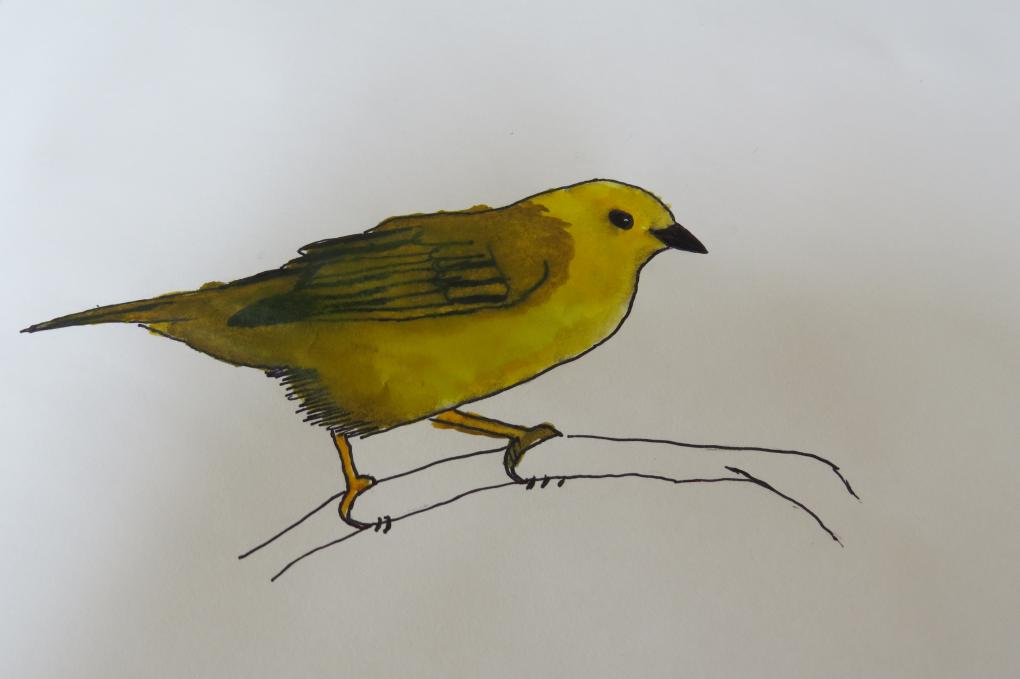
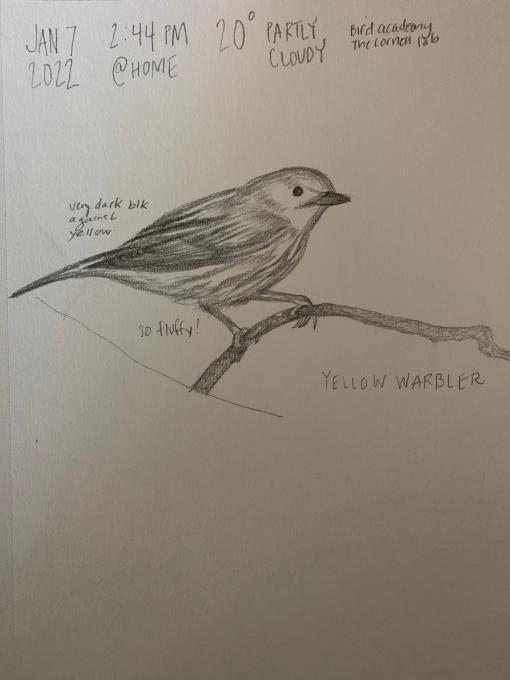
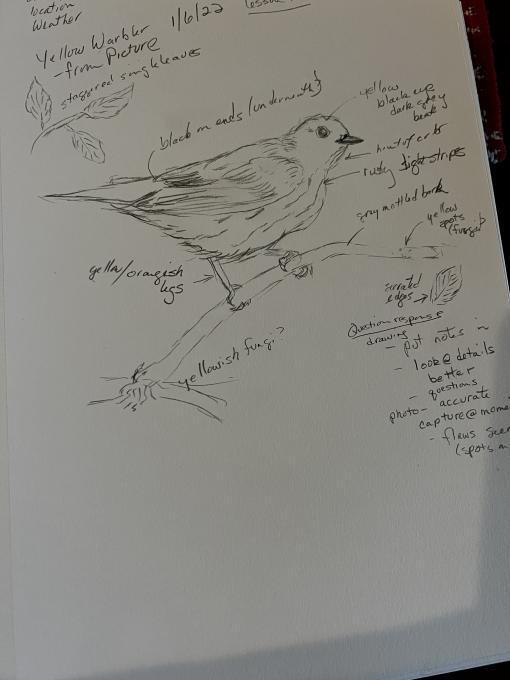
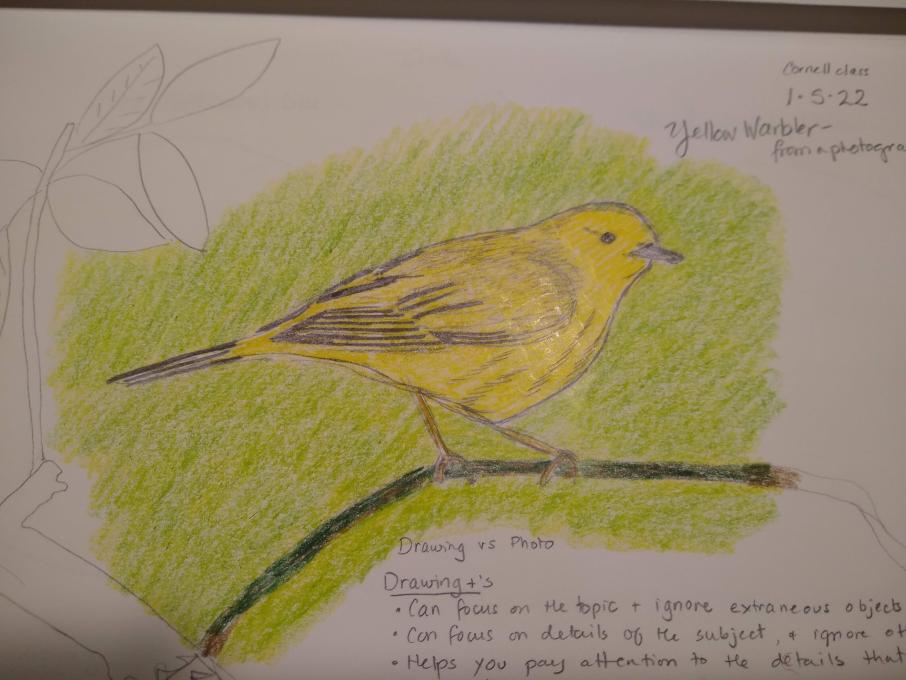 If this turns out to be a double submission, please excuse! I found that I can focus on the topic and ignore extraneous details, but I had to work on it, since everything in the photo was clear and detailed. This gave me an accurate portrayal of the bird, and I was able to concentrate on the details in a way that I wouldn't have been able to if I was doing this while watching it. Photos provide a good resource to go to when, after an observation outside, I want to go back and check details on what I've captured in drawing. On a technical note, I was concerned how I was going to show the various shades and tones of yellow, and scoured my pencil box for the "right" color to use. I finally landed on using one color, and found that my shading with a graphite pencil provided the shading I was looking for. A good lesson learned!
If this turns out to be a double submission, please excuse! I found that I can focus on the topic and ignore extraneous details, but I had to work on it, since everything in the photo was clear and detailed. This gave me an accurate portrayal of the bird, and I was able to concentrate on the details in a way that I wouldn't have been able to if I was doing this while watching it. Photos provide a good resource to go to when, after an observation outside, I want to go back and check details on what I've captured in drawing. On a technical note, I was concerned how I was going to show the various shades and tones of yellow, and scoured my pencil box for the "right" color to use. I finally landed on using one color, and found that my shading with a graphite pencil provided the shading I was looking for. A good lesson learned! 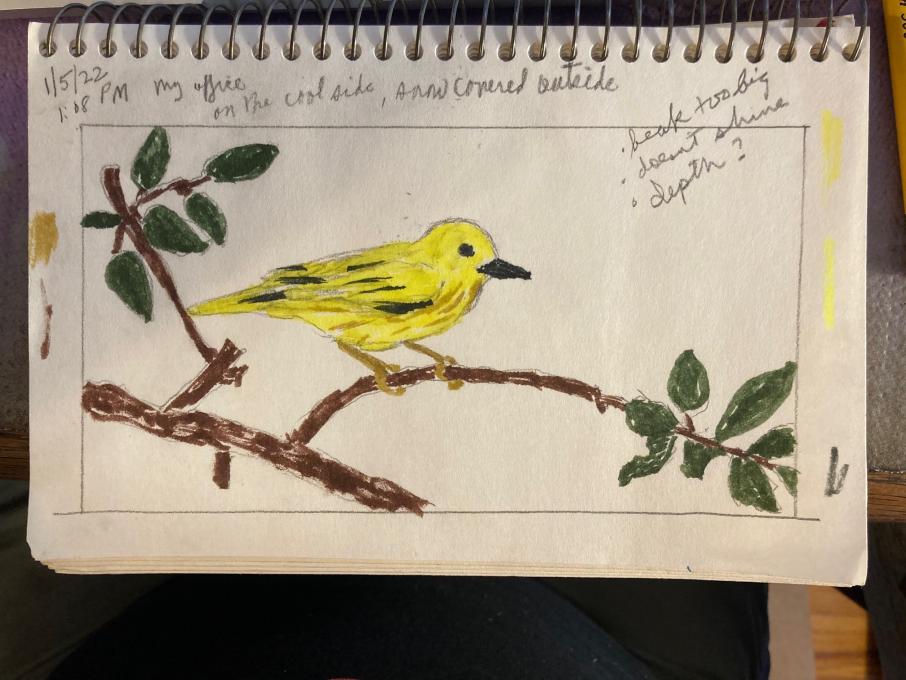
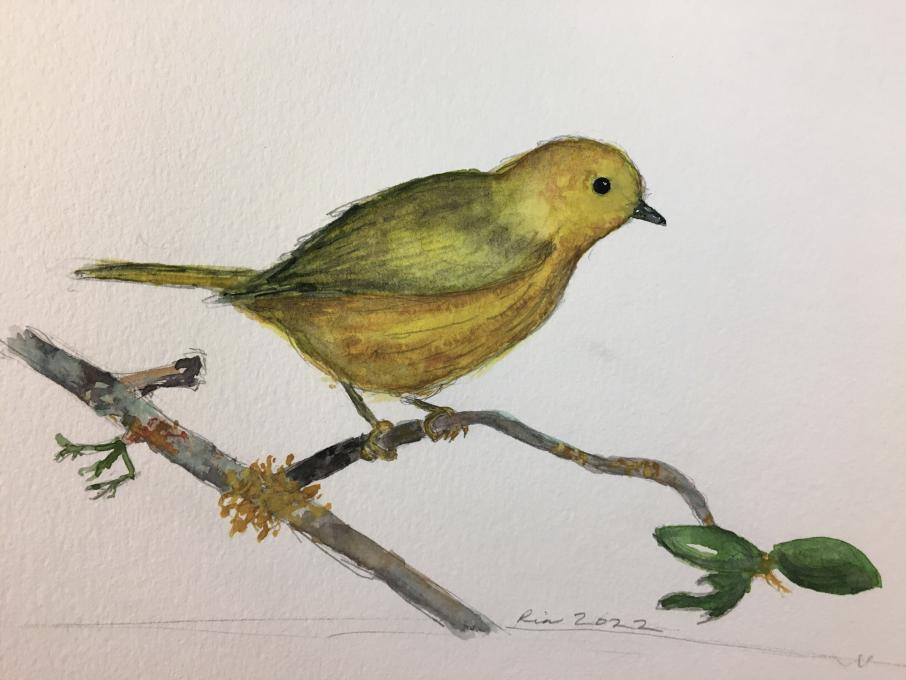
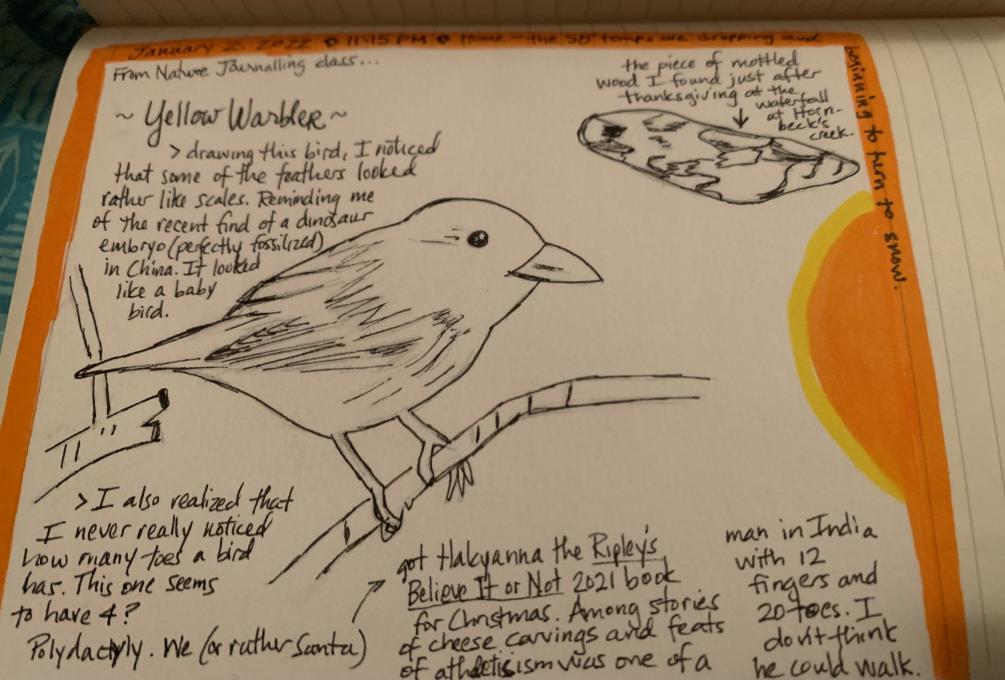
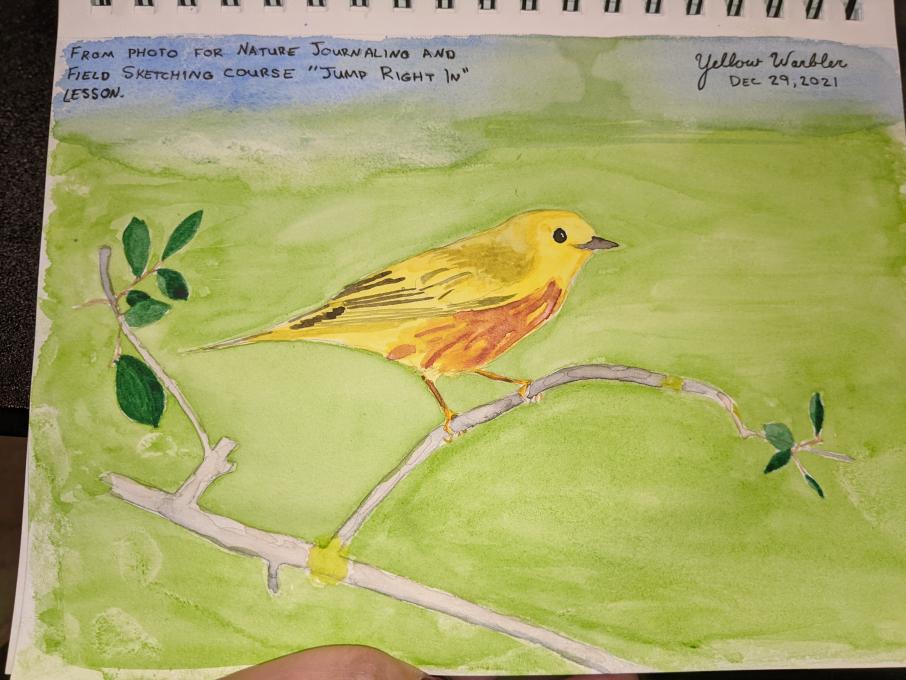
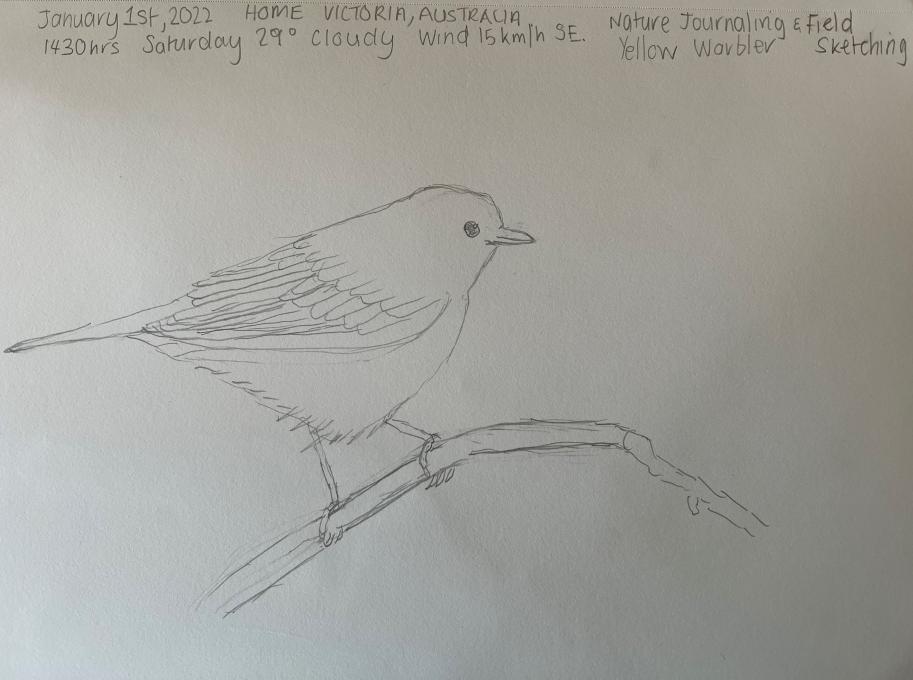 I feel ok with the drawing but defiantly with practice improve I'm sure.
I feel ok with the drawing but defiantly with practice improve I'm sure. 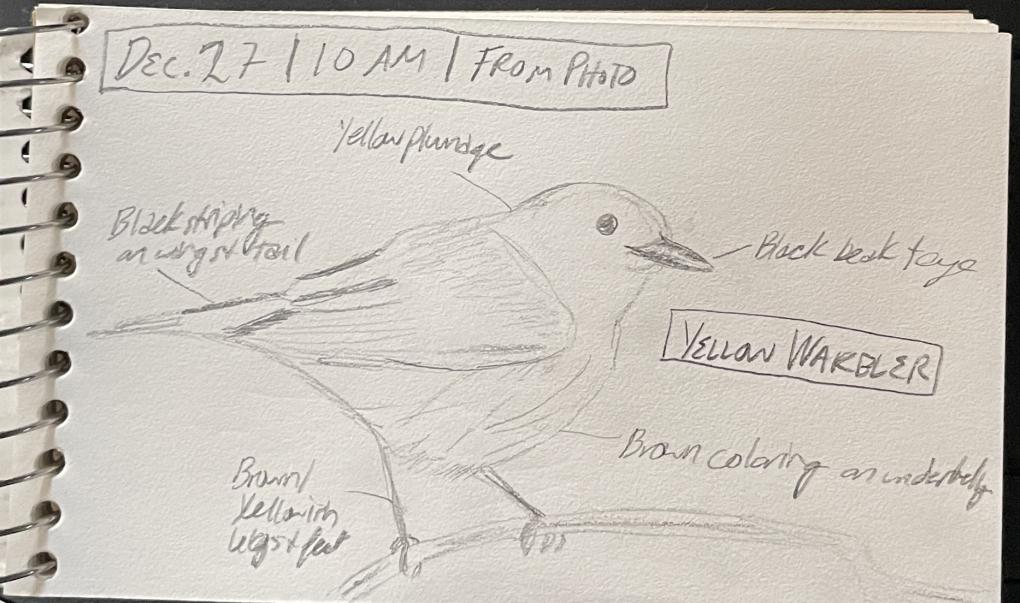 I don't have my full-sized journal yet so did this assignment on a small sketch pad--I think it will be easier with a larger surface to work on!
1. How did you feel about drawing from the photo? What came easily and what was challenging?
Honestly, I felt relieved I wasn’t trying to capture a bird in real time! It was still a challenge however. I wasn't sure where to start so found myself defaulting initially back to those geometric shapes learned in school–bird are ovals, as D.J. said! But once I felt I had the head and back shaped correctly, it was easier to fill in the other details proportionately. I struggled with the beak and made many revisions there, while the wings, legs, markings and branch came easier. I am very curious to learn strategies for field sketching, when birds, bugs, leaves, etc. are moving around and not holding perfectly still!
2. Was there anything in the photo that you might not have noticed if you weren’t asked to draw it? Would this make a difference when nature journaling?
There were many small details in the photo I didn’t notice until I reached that area on my sketch, like the fact that the markings on the underbelly are a different color than those on the wings. Leaving that out wouldn’t be detrimental to a nature journal, but the act of drawing and observing it adds more to the journaling experience. It’s a reminder to pause and stop our brains from filling in the blanks!
I don't have my full-sized journal yet so did this assignment on a small sketch pad--I think it will be easier with a larger surface to work on!
1. How did you feel about drawing from the photo? What came easily and what was challenging?
Honestly, I felt relieved I wasn’t trying to capture a bird in real time! It was still a challenge however. I wasn't sure where to start so found myself defaulting initially back to those geometric shapes learned in school–bird are ovals, as D.J. said! But once I felt I had the head and back shaped correctly, it was easier to fill in the other details proportionately. I struggled with the beak and made many revisions there, while the wings, legs, markings and branch came easier. I am very curious to learn strategies for field sketching, when birds, bugs, leaves, etc. are moving around and not holding perfectly still!
2. Was there anything in the photo that you might not have noticed if you weren’t asked to draw it? Would this make a difference when nature journaling?
There were many small details in the photo I didn’t notice until I reached that area on my sketch, like the fact that the markings on the underbelly are a different color than those on the wings. Leaving that out wouldn’t be detrimental to a nature journal, but the act of drawing and observing it adds more to the journaling experience. It’s a reminder to pause and stop our brains from filling in the blanks! 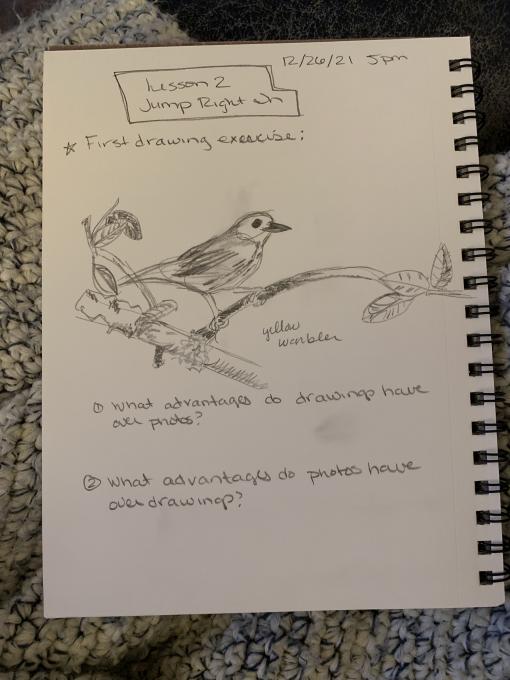 Well that didn't go as planned ;)
This was my first attempt at drawing anything in years. I need to get some drawing pencils. I didn't think to add color yet. Drawing did force me to notice details I would have missed-such as the streaking on the belly, and the way the feet sit on the branch. Details I would not have have likely noticed if looking at the live bird.
Well that didn't go as planned ;)
This was my first attempt at drawing anything in years. I need to get some drawing pencils. I didn't think to add color yet. Drawing did force me to notice details I would have missed-such as the streaking on the belly, and the way the feet sit on the branch. Details I would not have have likely noticed if looking at the live bird. 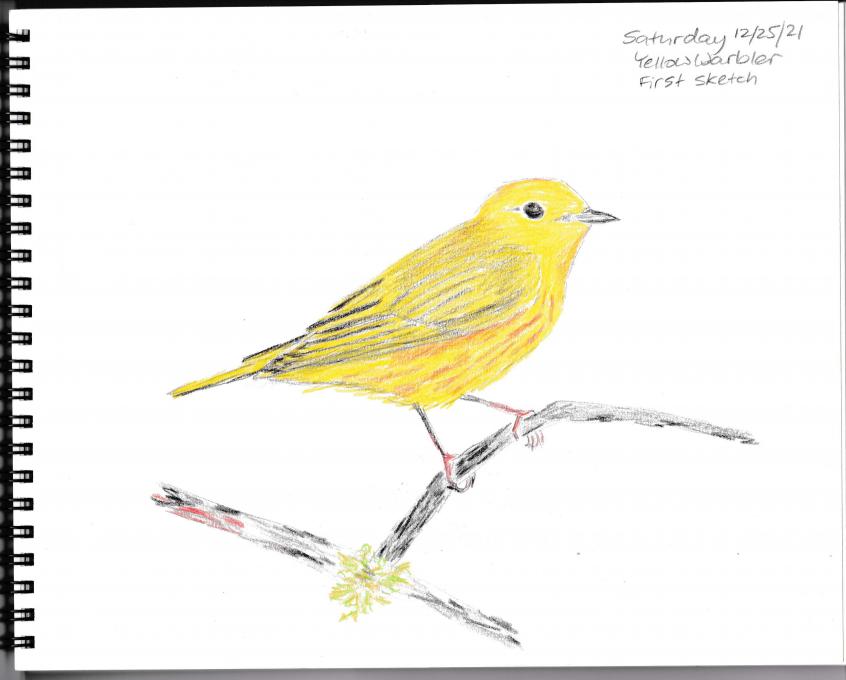
![IMG_5343[165]](https://academy.allaboutbirds.org/wp-content/uploads/hm_bbpui/852077/Tpsq4be7udoizf2o4wowri55t6wkuv1lg.jpg)
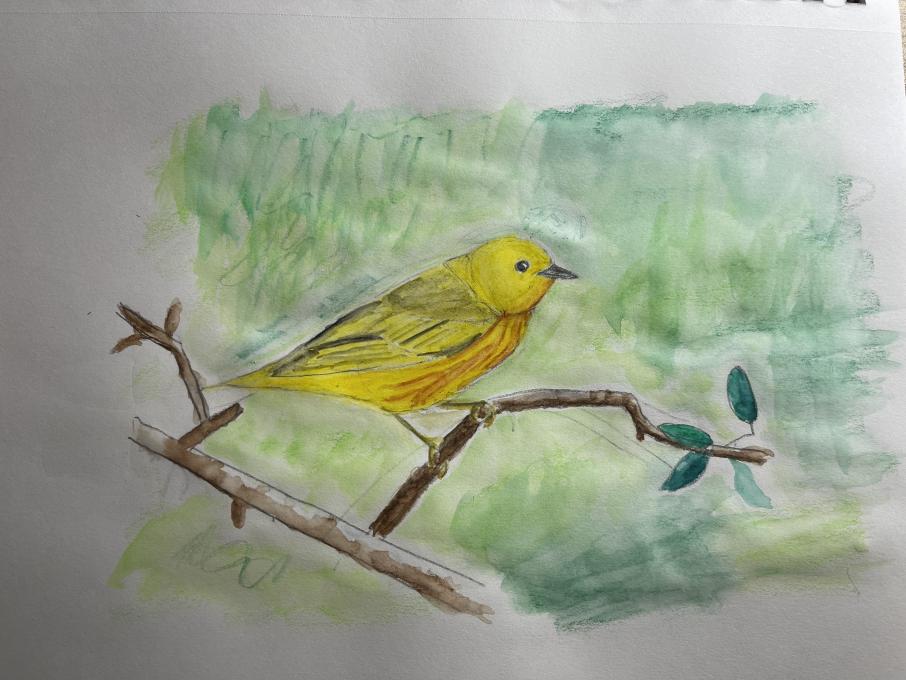
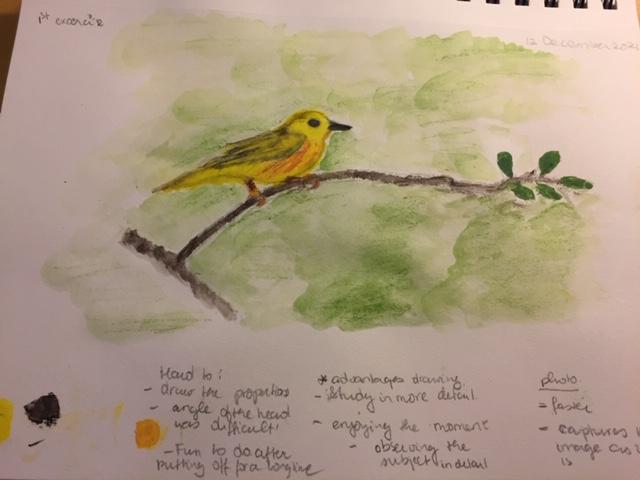
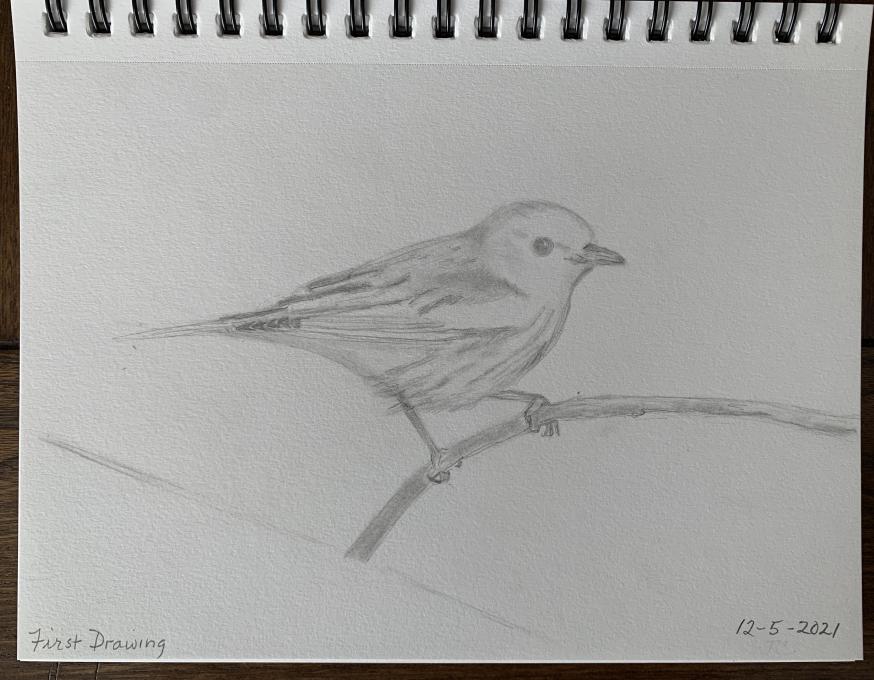 1. How did you feel about drawing from the photo? Good. It gave me lots of time to observe the bird.
2. What came easily and what was challenging? The wing was challenging. The head was easier--less detail.
3. Was there anything in the photo that you might not have noticed if you weren’t asked to draw it? Would this make a difference when nature journaling? I don't think I would have noticed all the black lines in the wing and the detail of the stripes on its chest. I guess the difference would depend on the purpose of the journal entry.
1. How did you feel about drawing from the photo? Good. It gave me lots of time to observe the bird.
2. What came easily and what was challenging? The wing was challenging. The head was easier--less detail.
3. Was there anything in the photo that you might not have noticed if you weren’t asked to draw it? Would this make a difference when nature journaling? I don't think I would have noticed all the black lines in the wing and the detail of the stripes on its chest. I guess the difference would depend on the purpose of the journal entry. 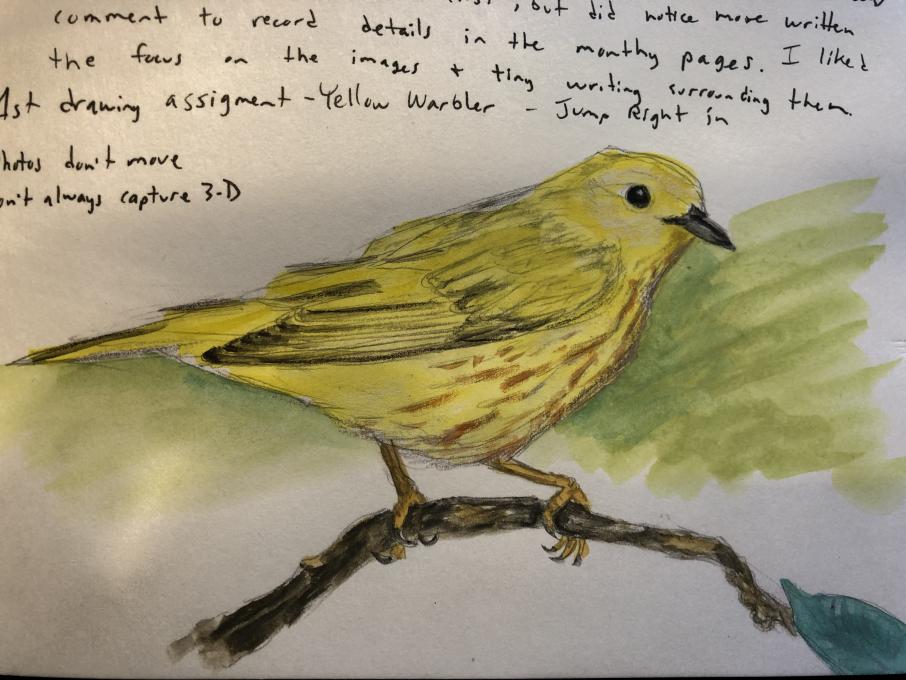 I love trying to draw/paint from a good photo like this. I think I got the form down pretty well. The proportions may be off a little, but not too bad. I felt like it wasn't as vibrant as I wanted it to be so I added a second darker color to the background for added contrast.
I love trying to draw/paint from a good photo like this. I think I got the form down pretty well. The proportions may be off a little, but not too bad. I felt like it wasn't as vibrant as I wanted it to be so I added a second darker color to the background for added contrast. 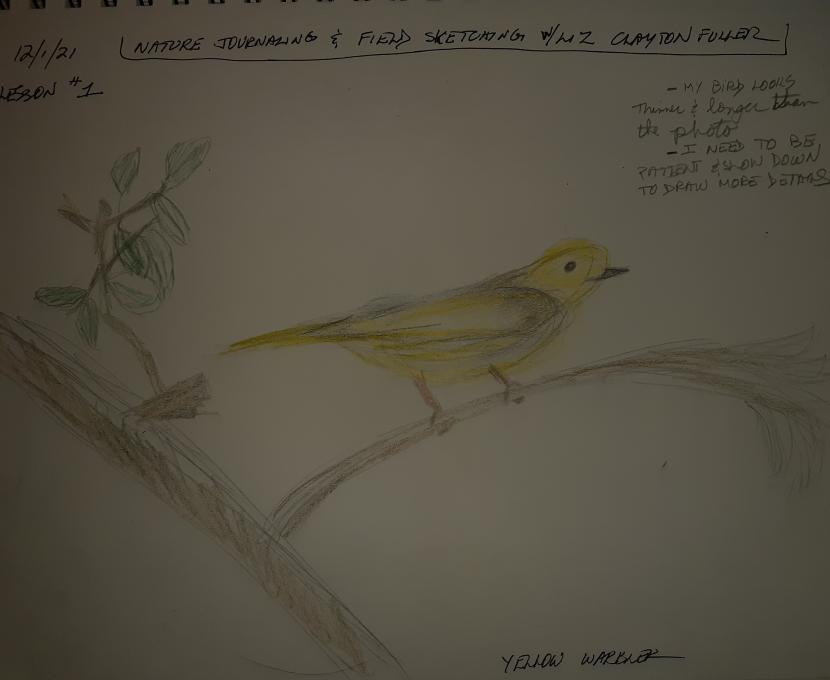
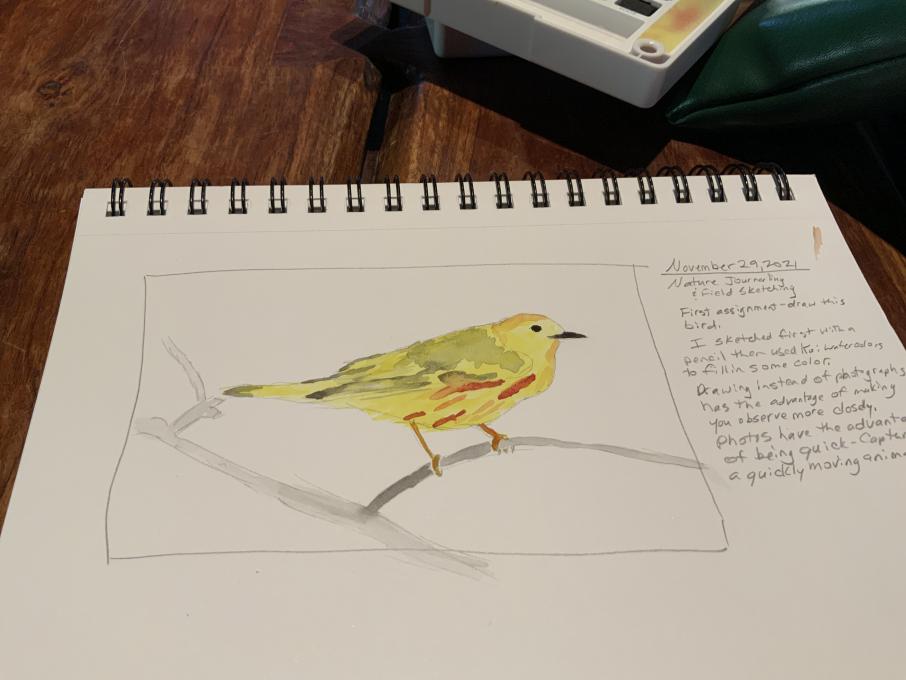 1. It was fun and interesting to draw from the photo. I noticed right away that preparing to draw/paint made me look much more closely at the details of the bird. The general shape was easy but capturing the nuances is hard. The particular way the bird is holding his head and body is hard to capture. 2. There is lots in the photo I would not have noticed, like the streaks of red on the breast and how some of the wing and tail feathers are primarily black. I would like to learn how to capture some of these important details without getting too hung up on trying to produce a ‘technical drawing’ of whatever I am seeing.
1. It was fun and interesting to draw from the photo. I noticed right away that preparing to draw/paint made me look much more closely at the details of the bird. The general shape was easy but capturing the nuances is hard. The particular way the bird is holding his head and body is hard to capture. 2. There is lots in the photo I would not have noticed, like the streaks of red on the breast and how some of the wing and tail feathers are primarily black. I would like to learn how to capture some of these important details without getting too hung up on trying to produce a ‘technical drawing’ of whatever I am seeing. 